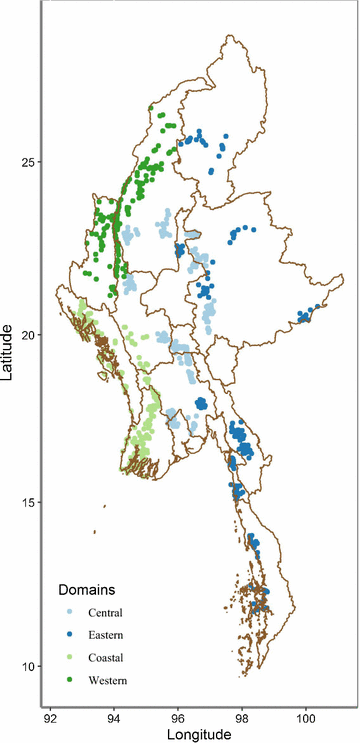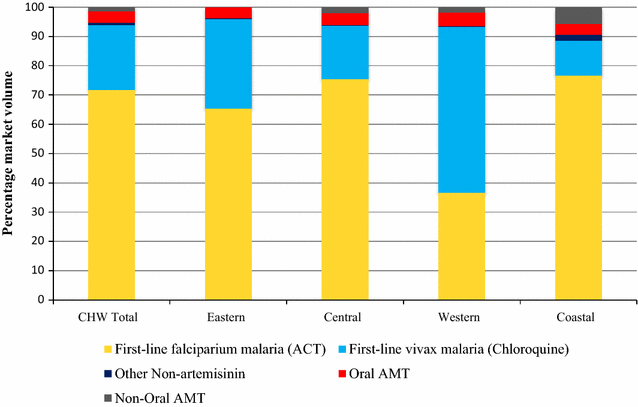Anti-malarial landscape in Myanmar: results from a nationally representative survey among community health workers and the private sector outlets in 2015/2016
- PMID: 28438197
- PMCID: PMC5404301
- DOI: 10.1186/s12936-017-1761-8
Anti-malarial landscape in Myanmar: results from a nationally representative survey among community health workers and the private sector outlets in 2015/2016
Abstract
Background: In 2015/2016, an ACTwatch outlet survey was implemented to assess the anti-malarial and malaria testing landscape in Myanmar across four domains (Eastern, Central, Coastal, Western regions). Indicators provide an important benchmark to guide Myanmar's new National Strategic Plan to eliminate malaria by 2030.
Methods: This was a cross-sectional survey, which employed stratified cluster-random sampling across four regions in Myanmar. A census of community health workers (CHWs) and private outlets with potential to distribute malaria testing and/or treatment was conducted. An audit was completed for all anti-malarials, malaria rapid diagnostic tests.
Results: A total of 28,664 outlets were approached and 4416 met the screening criteria. The anti-malarial market composition comprised CHWs (41.5%), general retailers (27.9%), itinerant drug vendors (11.8%), pharmacies (10.9%), and private for-profit facilities (7.9%). Availability of different anti-malarials and diagnostic testing among anti-malarial-stocking CHWs was as follows: artemisinin-based combination therapy (ACT) (81.3%), chloroquine (67.0%), confirmatory malaria test (77.7%). Less than half of the anti-malarial-stocking private sector had first-line treatment in stock: ACT (41.7%) chloroquine (41.8%), and malaria diagnostic testing was rare (15.4%). Oral artemisinin monotherapy (AMT) was available in 27.7% of private sector outlets (Western, 54.1%; Central, 31.4%; Eastern; 25.0%, Coastal; 15.4%). The private-sector anti-malarial market share comprised ACT (44.0%), chloroquine (26.6%), and oral AMT (19.6%). Among CHW the market share was ACT (71.6%), chloroquine (22.3%); oral AMT (3.8%). More than half of CHWs could correctly state the national first-line treatment for uncomplicated falciparum and vivax malaria (59.2 and 56.9%, respectively) compared to the private sector (15.8 and 13.2%, respectively). Indicators on support and engagement were as follows for CHWs: reportedly received training on malaria diagnosis (60.7%) or national malaria treatment guidelines (59.6%), received a supervisory or regulatory visit within 12 months (39.1%), kept records on number of patients tested or treated for malaria (77.3%). These indicators were less than 20% across the private sector.
Conclusion: CHWs have a strong foundation for achieving malaria goals and their scale-up is merited, however gaps in malaria commodities and supplies must be addressed. Intensified private sector strategies are urgently needed and must be scaled up to improve access and coverage of first-line treatments and malaria diagnosis, and remove oral AMT from the market place. Future policies and interventions on malaria control and elimination in Myanmar should take these findings into consideration across all phases of implementation.
Keywords: Anti-malarial; Artemisinin combination therapy; Chloroquine; Malaria testing; Oral artemisinin monotherapy.
Figures
References
-
- NMCP/Myanmar . National Strategic Plan. Malaria prevention and control 2010–2016. Naypyidaw: Department of Health; 2014.
-
- WHO . World Malaria Report. Switzerland: Geneva; 2015.
-
- World Health Organization and the National Malaria Control Programme Myanmar. Strategic framework for artemisinin resistance containment in Myanmar (MARC) 2011–2015. 2011.
-
- MoH. National strategic plan for intensifying malaria control and accelerating progress towards malaria elimination 2016–2020. 2016.
Publication types
MeSH terms
Substances
LinkOut - more resources
Full Text Sources
Other Literature Sources
Medical
Miscellaneous





